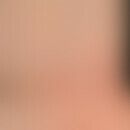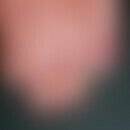DefinitionThis section has been translated automatically.
Oral lichen ruber is a T-cell-mediated immune reaction of unknown origin (Payeras MR et al. 2013), in which auto-cytotoxic CD8+ T cells induce apoptosis of basal cells of the oral epithelium on the one hand, and an inflammatory response on the other (Eversole LR 1997; Brănişteanu DE et al.2016). Oral lichen ruber usually occurs as a partial manifestation of classic lichen ruber (in about 30% of cases), less frequently as a localized form without skin involvement.
EtiopathogenesisThis section has been translated automatically.
The etiopathogenesis remains unclear. Triggering factors are bone marrow transplants, various drugs (see below Lichen ruber), dental prostheses, hepatitis-C and others (Montebugnoli L et al. 2012; Powell FC 1983).
You might also be interested in
PathophysiologyThis section has been translated automatically.
The mechanism of the cell-mediated immunological response begins with antigen expression in keratinocytes. This process is followed by the migration of T-cell lymphocytes, which is directly initiated by antigen binding to major histocompatibility complex (MHC)-1 on keratinocytes or by activated CD4+ lymphocytes (Zhou XJ et al. (2002). Activated CD8+ T cells in turn attack basal keratinocytes through tumor necrosis factor (TNF)-alpha, Fas-FasL- or granzyme B- mediated apoptosis (Sugerman PB et al (2000).
LocalizationThis section has been translated automatically.
Oral lichen ruber occurs with different clinical forms, usually bilaterally symmetric, less frequently unilateral, with involvement of the buccal oral mucosa, dorsal and ventral surfaces of the tongue and/or gingiva. Palatal and labial localization is rather rare.
ClinicThis section has been translated automatically.
The following clinically oriented classification can be used:
Type I (white papule or plaque type): Mostly streaky, punctate, annular, reticular also planar whitish papules or plaques, which may confluence especially retroangularly and in the area of the entire dental cusp (Köbner phenomenon) to large opal plaques. Rarer is a small-papular mucosal type. Underlying erythema (of lichen planus inflammation) is not always found visibly (covering phenomenon of overlying orthokeratotic mucosal keratinization). The changes are usually not painful. The red of the lips may be involved, but may also be affected in isolation. Occasionally, brownish hyperpigmentation develops. The tongue may be affected by both areal opal plaques, which are better seen only with lateral vision. In parallel, coarsening of the surface relief may be observed (reflecting diffuse lichenoid inflammation). Some patients (about 1%) report taste disturbances.
Type II (red or erosive type ): second most common manifestation form of lichen ruber mucosae (see below lichen ruber erosivus mucosae). The symptoms are painful erythema, erosions or ulcers over a large area (especially after ingestion of acidic food or drinks). The leading clinical symptom in the erosive type is "pain", which occurs promptly, especially with dietary errors. Erosive lichen ruber has a significant risk of malignant transformation (0.5-2.0%). Rarely, a bullous variant is detectable.
Type I/Type II in different mixed forms.
HistologyThis section has been translated automatically.
Band or patchy, usually lymphocytic infiltrate in the lamina propria confined to the epithelial-lamina propria interface, basal cell liquefaction (hydropic) degeneration, lymphocytic exocytosis, without epithelial dysplasia or verrucous epithelial architectural change.
DiagnosisThis section has been translated automatically.
The diagnosis of oral lichen ruber or oral lichenoid lesion is a clinical diagnosis. The diagnostic criteria were introduced by WHO in 1978 (WHO Collaborating Centre for Oral Precancerous Lesions 1978) and modified by van der Meij and van der Waal in 2003 (van der Meij EH et al 2003). In 2016, the American Academy of Oral and Maxillofacial Pathology (Kamath VV et al. 2015) proposed new clinical and histopathological criteria.
In case of clinical doubt (especially to exclude malignancy), histopathological examination is necessary.
TherapyThis section has been translated automatically.
2% lidocaine gel can be applied to relieve acute pain.
- Topical corticosteroid externals: Topical corticosteroid externals were recommended as initial treatment in the consensus guidelines published in 2005. Depending on the severity of the lesions and the personal experience of the physicians, the available drugs can be used as follows:
- Soluble prednisolone tablets, mouth rinse 3 or 4x in 24 hours (5 mg dissolved in 15 ml water).
- Alternative:.Betamethasone tablets (500 mg) dissolved in 10-15 ml of water, for mouth rinsing up to 4 times/day.
- Alternative: beclometasone dipropionate, fluticasone propionate, metered dose inhalers, use as a mouth spray and apply to lesions up to 3-4 x/day (Lodi G et al 2005).
- Alternatitv: corticosteroid-containing nasal sprays that can be sprayed directly on the lesions (e.g., triamcinolone acetonide nasal spray) have proven effective.
- Alternatitv: Apply clobetasol ointment (0.05%) lesionally 3-4x/day.
- Alternatv: Fluticasone cream (0.05%) applied lesionally 3-4x/day. (Tyldesley WR et al 1997).
- Comment: One of the main disadvantages of topical corticosteroids is that they adhere to the mucosa only for a limited time.
- Alternative: In view of this, topical steroids such as betamethasone valerate, clobetasol, fluocinolone acetonide, fluocinonide, and triamcinolone acetonide have also been incorporated into carboxymethyl cellulose/hydrophobic base gel adhesive formulas with paraffinum subliquidum (e.g., triamcinolone acetonide adhesive paste NRF 7.10.). This can be used to achieve a longer topical residence time.
- Alternatively, systemic steroids can be applied, possibly in combination with immunosuppressants (Carbone M et al. 2003).
Progression/forecastThis section has been translated automatically.
Oral lichen ruber is an eminently chronic disease with a relapsing course. Disease activity may vary in each patient (Potts AJ et al 1987). Goals of treatment are elimination of painful symptoms, elimination of ulcerative lesions, prolongation of symptom-free periods. A prerequisite for this is good oral hygiene and a good dental status (Rotim Z et al. 2015). Furthermore, dietary measures are inevitable: avoidance of all spicy, salty, acidic or spicy foods. Avoidance of smoking and alcohol consumption. A potentially increased risk of oral cancer can be assumed in smokers. Local carcinoma risk also seems to be increased in erosive and atrophic lesions, as well as in longstanding oral lichen ruber (Ostman PO et al 1996).
Note(s)This section has been translated automatically.
A lichen ruber mucosae is described as an "oral lichenoid reaction", which occurs in the immediate vicinity of amalgam fillings on the buccal mucosa of the cheek, tongue or gingiva. Some authors postulate an independent entity (see notes below).
Gingiva: When the gingiva is affected, chronic erosive gingivitis appears. The "leukoplakic" aspect is often absent. In addition to extensive, red erythema, there are extensive, extremely painful erosions, which become symptomatic when acidic foods or juices (e.g. orange juice) are consumed.
LiteratureThis section has been translated automatically.
- Brănişteanu DE et al.(2016) Histopathological and clinical traps in lichen sclerosus: A case report. Rome J Morphol Embryol. 57 (Suppl 2): 817-S823.
- Canto AM et al (2010) Oral lichen planus (OLP): Clinical and complementary diagnosis. An Bras Dermatol. 85:669-675.
- Eversole LR (1997) Immunopathogenesis of oral lichen planus and recurrent aphthous stomatitis. Semin Cutan Med Surg. 16:284-294.
- Kamath VV et al (2015) Oral lichenoid lesions - a review and update. Indian J Dermatol. 60
- Lodi G et al. (2005) Current controversies in oral lichen planus: report of an international consensus meeting. Part 2: Clinical management and malignant transformation. Oral Surg Oral Med Oral Pathol Oral Radiol Endod 100:164-178.
- Montebugnoli L et al. (2012) Clinical and histologic healing of lichenoid oral lesions following amalgam removal: A prospective study. Oral Surg Oral Med Oral Pathol Oral Radiol. 113:766-772.
- Payeras MR et al.(2013) Oral lichen planus: Focus on etiopathogenesis. Arch Oral Biol. 58:1057-1069.
- Potts AJ et al. (1987) The medication of patients with oral lichen planus and the association of nonsteroidal anti-inflammatory drugs with erosive lesions. Oral Surg Oral Med Oral Pathol. 64:541-543.
- Powell FC (1983) Primary biliary cirrhosis and lichen planus. J Am Acad Dermatol. 9:540-545.
- Rotim Z et al. (2015) Oral lichen planus and oral lichenoid reaction - an update. Acta Clin Croat. 54:516-520.
- Rotaru D et al. (2020) Treatment trends in oral lichen planus and oral lichenoid lesions (Review). Exp Ther Med 20:198.
- Srinivas K et al (2011) Oral lichen planus - review on etiopathogenesis. Natl J Maxillofac Surg. 2:15-16.
- Sugerman PB et al (2000) Autocytotoxic T-cell clones in lichen planus. Br J Dermatol. 142:449-456.
- Thompson MA et al (2004) Treatment of erosive oral lichen planus with topical tacrolimus. J Dermatolog Treat 15:308-314.
- Tyldesley WR et al (1997) Betamethasone valerate aerosol in the treatment of oral lichen planus. Br J Dermatol. 96:659-662.
- van der Meij EH et al. (2003) Lack of clinicopathologic correlation in the diagnosis of oral lichen planus based on the presently available diagnostic criteria and suggestions for modifications. J Oral Pathol Med 32:507-512.
- WHO Collaborating Centre for Oral Precancerous Lesions (1978). Definition on leukoplakia and related lesions: An aid to studies on oral precancer. Oral Surg Oral Med Oral Pathol Oral Radiol Endod. 46:518-539.
- Zhou XJ et al (2002) Intra-epithelial CD8+ T cells and basement membrane disruption in oral lichen planus. J Oral Pathol Med. 31:23-27.
Incoming links (1)
Lichen planus mucosae;Outgoing links (3)
Lichen planus classic type; Lichen planus (overview); Triamcinolone acetonide adhesive paste (nrf 7.10.);Disclaimer
Please ask your physician for a reliable diagnosis. This website is only meant as a reference.




